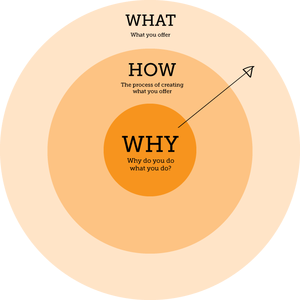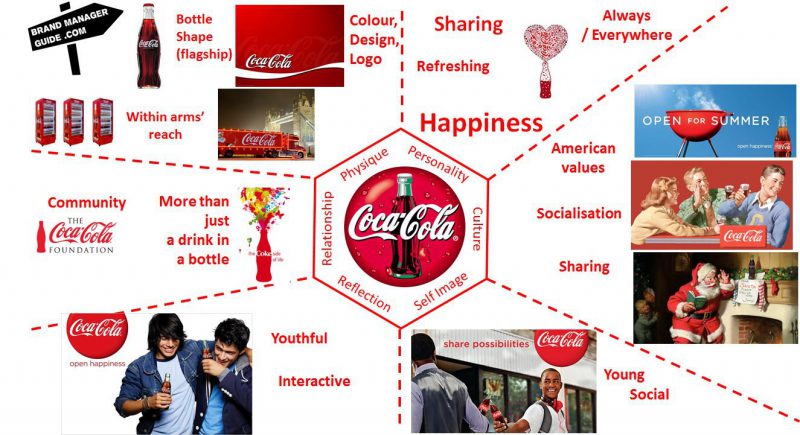
Branding and Brand Marketing are the two most confusing concepts in marketing, and longtime brand strategists are sometimes confused. Not to mention these two terms are often called interchangeably when people talk about brands. In the world of SMEs, the line between Branding and Brand Marketing is more blurred than ever. Although there are many connections and similarities, they still have many fundamental differences, because otherwise people would not have separated for anything. So what is Brand Marketing? And what is the role of Brand Marketing? Let’s find out with Malu Design through the article below!
What is Brand Marketing?
Brand marketing is brand marketing that includes activities that promote your products or services in a way that highlights your overall brand.
Brand marketing is about associating the colors and highlights of your brand with your target customers. Basically, your brand is the bridge between your product and your customers.
Brand marketing is more than just putting your logo and business name in as many places as possible and expecting to generate sales. Many times, the importance of brand marketing is overlooked because it takes a lot of effort and time for the business.
Today’s business divisions are more concerned with short-term goals. Instead of cultivating long-term goals that impact the entire business, like branding.
A strong brand today requires a personality that is in sync with the customer. On all platforms, from social networks to billboards, to its packaging.
Modern branding can be defined as art. Expresses a company’s identity from who they are, what they do, the level of quality they offer, to their reputation.
In the past, marketing focused only on the product, with the strategy revolving around the concept of the product life cycle . Philip Kotler’s theories still revolve around the concept of the product. In the last decades of the 21st century, leading multinational corporations in the field of consumer goods have pioneered a brand-centric marketing and management model. as well as of corporate governance. We study this issue and complete the brand marketing theory, summarized through the points. Consider these as the first theoretical foundations of “Brand Marketing” in Vietnam.
Brand Marketing strategy is an indispensable part of an enterprise’s overall business strategy, plays a strong role in promoting the consumption of goods, creating a legitimate source of profit, and affirming the position of the business. industry in the market.

It should be noted that brand marketing redefines the whole product, not as a confusion between brand marketing (brand marketing) and branding (branding). By the argument “brand is the pinnacle of the product” brand marketing is the most comprehensive marketing system today.
Brand Marketing is one of the aspects that businesses will need to deploy to boost revenue and scale of operations.
It is considered as a trend for modern marketing activities. Brand Marketing is the process by which you promote and market intangible values such as the name, reputation of the brand, the price of the brand’s products, etc.
Or, understood in another way, the job of Brand marketing is to help the brand be imprinted in the minds of customers, creating an emotional bridge between the business and the customer. Brand is what other people say about your brand when you are not there.
Distinguishing between Branding and Brand Marketing in marketing
Brand Marketing and Branding, are 2 different activities. Brand marketing focuses on brand marketing through services/products, while branding will focus on branding activities.

The difference between Branding vs Brand Marketing is not like the chicken and the egg story – which comes first. Because if you ask me, I’m pretty sure it’s Branding. In the historical development flow of marketing, Branding has appeared from the very beginning, while Brand Marketing is a new trend of the modern world. However, these two concepts are easily confused due to the development of Branding in recent decades.
In the past, when the marketing industry was in its infancy, people only focused on products, with the main strategy revolving around the concept of PLC (product life cycle). Today, brand management gradually becomes the center of development strategy as well as the core of corporate governance. It leads to a situation, when the number of products on the market is increasingly diverse and the positioning becomes confusing, the line between the differences becomes difficult to discern, and consumers are faced with a large amount of information. With so many options to choose from, it has led to the transformation of Branding.
Branding is different now, from the root position, it has crept into every corner of the business, affecting the entire strategy from the top level to the smallest execution. However, Branding alone is not enough, there must be Brand Marketing as a catalyst to help the brand sublimate in the market. And on the way to brand success, always remember the parallel of both Branding and Brand Marketing. As a business owner, especially a marketer, the distinction between Branding and Brand Marketing is extremely necessary.
Learn more >>> What is a Brand? The easiest definition of a Brand
Role of Brand Marketing
For large businesses , Brand Marketing is a part of Marketing, aiming to develop the product’s brand. Together with other departments such as Digital Marketing, Content Marketing, Viral Marketing, … will contribute a part to help develop the brand.
Large multi – product enterprises will focus on Brand Marketing activities on certain lines . Every new product when born will have a Brand. In short , these Brands navigate to the main Brand of the brand, also known as the Parent Brand.

For small and medium-sized companies that only deal in a single product , Brand Marketing cannot be divided into a separate department, but will go hand in hand with integrating product brands with corporate brands.
Remember this , after all, customers not only buy your products/services, but also buy your brand. Your brand will play an important role in pricing your product or positioning you without customer perception.
For example, why customers choose the brand-name pain reliever, Tylenol. Instead of unbranded options that will give them more value? Because the brand is consistent, recognizable, and trustworthy.
Having strong brand equity allows businesses to charge more for the product. And create brand extensions like new product release – Tylenol PM.
Apple is an example of a company with top brand values. It has built an authentic brand by positioning itself as an innovative pioneer in the technology industry.
The brand focuses on product quality but also uses differentiated media. Creative to reinforce the sale of a particular product as well as the overall brand. When they launched the MacBook Air laptop. The ad showed the special features of the product through the distinct lens of the Apple brand.

Steps to build a brand marketing strategy
Step 1: Define clearly what is the real purpose of Brand Marketing?
Every successful brand has a really big vision behind it. This is very important in helping you to clearly define your mission. And your business has a foundation to survive and grow, but rarely lose direction. You can simply understand purpose is what you know you will do to help users solve their problems.
Four questions you should ask yourself when defining your brand’s mission:
- Why should your business exist?
- What is your difference from other businesses in the same field?
- What problem is your business solving?
- Why should users care about your brand?
Let’s rely on these ideas to be the foundation for the establishment of the brand, map out a cross-cutting slogan, message, tone, vision, core values and tone for the business.
The deeper you go into these 4 questions, the more you will be able to see the truth as well as the value of the advantage you have. You can easily be different from other businesses
In addition, you can also find the mission of the business through the “golden circle” theory:

The three important parts of this “golden circle” are:
- Why: Why do you sell that product/service? Why must you exist?
- How: How will your business stand out from the competition?
- What : What product or service do you offer to your customers?
Learn More >>> Why Brands Need Tagline, Slogan, Mission And Vision
Step 2: Research and analyze competitors in the field
Malu Design’s advice to you is not to copy exactly the big brands in your field. Instead, you should consider what is the core of their success. Especially their failures in the past and learn from the experience.
The ultimate purpose of competitor analysis is that you need to set your brand apart. Convince customers why they should buy your product and not them?
Most businesses deploy Marketing campaigns for Brands based on reviewing successful, recognized or trusted lessons. This could be a great idea! You absolutely should not skip this step!
Analyze the major competitors in your field, for example, how they build their brand, name the brand. The next step is to create a table of competitor brands after the analysis process.

- Are the competitors aligned with the messages or vision they have set out across the channels?
- How is the quality of competitor brand products and services?
- What do you read about the reviews on your competitors’ social media sites, both positive and negative?
- Analyze how their market works both online and offline
Step 3: Segment your target audience
The foundation of branding is deciding on a specific audience you target.
When building a brand, determine in the most specific and precise way the target customers you target. You will easily find your mission and message geared to the needs of your customers
The most important key is concreteness. Find out the behaviors and lifestyles in detail with your potential customers
For example, instead of defining the target customer as all mothers, you should clearly define the mothers here, age, occupation. For example single mothers, over 30 years old, office workers
Or or identify those who are in need of work, you can be more specific, retirees who want to earn more income, or nursing mothers who want to earn more.
The point is that when you identify a niche, you can go deep into that niche, so the value given will be more specific and conversion value as well as you will know where to start. You will easily realize your brand’s competitive advantage when you reduce the extent of your focus on a specific target audience.

Demographics:
The creation of brands is based on a deep understanding of buyer characteristics. Here are the things that you need to gather to describe your leads:
- Age
- Sex
- Location
- Income
- Academic level
And if possible, collect some of the following information:
- Feeling
- Target
- The problem is facing
- Influencers
- Rival brands
Defining the target audience for your product/service is an exercise that you need to do every day as it affects and benefits all aspects of your branding, especially your efforts. force becomes more in the right direction. All your promotional campaigns will target the right customers as they will receive and read your ad, click on your ad and read your emails leading to higher conversion rates.
As a result, clearly defining your target audience will play an important role in formulating branding strategies. It is a very important first step!

Read more >>> What is a Persona? Building Customer Portraits
Step 4: Create your brand mission statement
Have you ever thought about the brand mission of your business? In fact, that’s how you clearly show the strengths of your business. You need to answer the question of why you wake up every day.
First of all, you need to build trust with potential customers. You need to clearly define the value that the business provides to the market.
The mission statement defines the mission that exists.
Everything from your logo to your tagline, tone, message, etc. should be mission-oriented
When building your brand, start with a small focus step and remember to focus on the niche you are working on
Step 5: Outline the key benefits your brand brings
The products, services and benefits you promote should be exclusivity, meaning only you can offer to the market.
Let’s start with the most memorable brand that can appear in most situations in everyday life, focusing on the benefits your business brings.
Do not stop at providing products and services, you also need to increasingly improve the quality of your services, how to increasingly optimize the quality of life and improve problems for customers.

Here are some examples you can refer to:
- Customer service is more and more sincere and trustworthy
- Better ways to improve productivity
- Discounts with a wide selection of prices
- Save more time
Step 6: Clearly define the feeling you want to bring to the customer
The business tone you want to convey to your customers is based on the company mission. In a nutshell, it is how you interact with your customers and how they react to your business.
A few tones you might often recognize:
- Professional
- Friendly
- Power
- Provide information
If you identify the right tone of your business and direct your business to that tone, you will have a stronger ability to connect with your customers.
Step 7: Build a Brand Message and Story
When building a brand, try to be as concise as possible about your business. Remember the tone you just chose for your business and go in this direction.
The message you want to convey needs to have a close connection with the business brand and definitely stick to that message.

Brand story plays an important role. It is an opportunity for you to reach a certain level of customers, creating strong emotional bonds with your customers. Note, with storytelling, you should use the most sincere and understandable language, avoiding the use of specialized terms. In general, the simpler the better.
One note is that when developing a story, do not go too deep into the product feature but ask the question: why is it important to your customers.
Learn more >>> What is Brand Story? Steps to Telling a Compelling Brand Story
Step 8: Create logo and tagline
In the whole process of Branding Marketing, perhaps vision is the first point to pay attention to. We even find logos or slogans interesting and dive into other elements and vice versa. This is a step that requires a lot of creativity and imagination.
The logo will appear everywhere relevant to your business. It will become the identity of your business, the impression as well as the prospects you bring to customers.
Important things you need to keep in mind to build a quality and stylish brand logo.
- The arrangement and size of the logo
- How to choose color tones
- How to present prints and fonts
- How to create icons
- Image style
- Depends on factors when placing on your website

Step 9: Create consistency between Brand and all aspects of your business
Your brand should be seen and reflected in everything your customers can see, read and hear. It’s hard to understand, isn’t it?
If a customer walks in your office or a store, the brand image needs to be reflected not only in the environment, on the uniform, but necessarily in the way or attitude of service to the customer. client
Any tangible items from postcards to fliers, packages and products, etc. need to be stamped with a logo
Your website plays an important role in the Branding Marketing process. When you design a website, it is necessary to incorporate elements of tone, message, and personality in each content
In addition, with social networking sites such as Facebook, Video, Instagram, … is also one of the channels you need to direct in unifying elements such as message, tone, logo, company mission, ..

Step 10: Build, develop right with the brand you build
If you do not intend to change the brand after a long process of measuring results. Be consistent with your brand. Remember, consistency is the key to branding
Once you have established the business tone, the business mission, you should use them daily in the articles on the website.
Elements of a successful brand marketing strategy
When building a brand, what is the importance of brand marketing? That is you have to make a long term plan. All brand marketing strategies should be guided by establishing a company vision, defining a target audience, creating consistency, and conveying emotion.
Understand company vision
Your company should first decide what it wants to be known for. Then develop a strategy to get the message across all available marketing channels.
For example, does your company want to be known as the leading innovator in your industry like Apple? Or perhaps a provider of joy and happiness like Coca-Cola? What about power supplies for athletes like Nike?
Or even a supplier of all things valuable like Walmart? Monster Energy. For example, initiated a brand marketing campaign that involved having their drinks branded with famous Formula One drivers such as Lewis Hamilton and Valentino Rossi.
Monster wants to be known as an edgy and adventurous energy drink that fuels fearless Formula 1 drivers. Fans of these champions will define their success with energy drinks.

The target audience must align with the strategy
If you don’t define your target audience properly, your brand marketing efforts may fail. A target market is much more than understanding basic demographics.
Many marketers fall into the trap of saying “I will target anyone who wants to buy my product”. Or I would target all mothers in the UK. Instead, a target market should be broken down by psychologists. And explain by creating the buying personality.
For example, let’s say you are an all-natural ice cream company. Instead of setting your goal as “mothers with young children”. The goal should be “parents between the ages of 28 and 38 who have children of primary school age. Focus their purchases on sales and discounts. But put value in the ingredients of the products they serve to their children. “
You should also have plenty of personality in this one target market. For example, mothers have different shopping habits, or have feelings for brands. Once you’ve established a strong target audience, move on to creating a consistent brand.

Have a specific message for the business
The message used in Brand Marketing is the content that businesses want to convey to their customers. The messages need to be inspired by the business, the ideas throughout to increase brand recognition.
And the main task of marketers is to build content to attract and reach many different customers. Make an impression on your customers.
Choose a communication channel suitable to the industry/product
For brand marketing campaigns, choosing the right communication channel determines 70% of the success of the whole campaign. The right communication channel must ensure factors such as: being interested by customers, having a large number of followers, and being in line with the trend.
And a number of communication channels are highly appreciated today, businesses can apply such as newspapers, TV channels, social networks…

Create Consistency
Consistency is vital to building trust and loyalty. McDonald’s is an example of a brand that has maintained some of the strongest consistency over the past few decades. Upon seeing the infamous Golden Arches. They can almost taste the fries, or visualize the inside of the restaurant.
One way to ensure consistency is to build awareness and trust online. As most, if not all companies use some form of online marketing. Creating brand consistency online can be the first and least expensive step to developing a consistent brand.
While consistency is an important aspect of brand marketing, it can be a challenge to track and measure. To reinforce the overall consistency and trust of the brand. Use branded links when sharing any links, both online and in person. Links bridge the gap between brands and their audience. When you use branded links, you are attaching your company name. In every piece of content you’re sharing, this also creates consistency.




